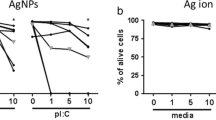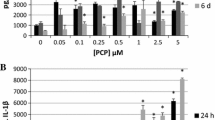Abstract
Human natural killer (NK) cells are central in immune defense against tumor and virally infected cells. Ziram is used as an accelerating agent in latex production and as an agricultural fungicide. Previous studies showed that continuous exposure to ziram inhibits NK lytic function. Additionally, they showed that a brief (1 h) exposure to ziram caused persistent loss of lytic function. This study examined whether decreases in lytic function were accompanied by decreases in the target-binding function of NK cells and found that some, but not all, exposures to ziram caused significant decreases in binding function. Ziram exposures that caused a loss of binding function were examined for effects on expression of key NK cell-surface proteins needed for binding to targets. Exposure to 2 μM ziram for 1 h followed by 24 or 48 h in ziram-free media decreased CD16 expression, but no other exposures caused decreases in cell-surface proteins. As decreases in adenosine triphosphate (ATP) could be in part responsible for loss of lytic function, the effect of ziram exposures on ATP levels of NK cells were examined. Certain ziram exposures decreased ATP levels in NK cells, but a decrease in ATP was not necessarily associated with a decrease in lytic function. The results indicate that ziram-induced losses of lytic function cannot be fully explained by alteration in binding, cell-surface protein expression, or ATP levels




Similar content being viewed by others
References
Caldas ED, Conceicao MH, Miranda MCC, deSouza LCKR, Lima JF. Determination of dithiocarbamate fungicide residues in food by a spectrophotometric method using a vertical disulfide reaction system. J Agric Food Chem. 2001;49:4521–5. doi:10.1021/jf010124a.
De Jong WH, Tentji M, Spiekstra SW, Vandebriel RJ, Van Loveren H. Determination of the sensitizing activity of the rubber contact sensitisers TMTD, ZDMC, MBT, and DEA in a modified local lymph node assay and the effect of sodium dodecyl sulfate pretreatment on local lymph node responses. Toxicology. 2002;176:123–34. doi:10.1016/S0300-483X(02)00131-2.
Dudimah FD, Odman-Ghazi SO, Hatcher F, Whalen MM. Effect of tributyltin (TBT) on ATP levels in human natural killer (NK) cells: relationship to TBT-induced decreases in NK function. J Appl Toxicol. 2007;27:86–94. doi:10.1002/jat.1202.
Edwards IR, Ferry DG, Temple WA. Fungicides and related compounds. In: Hayes WJ, Laws ET, editors. Handbook of pesticide toxicology. Volume 3, Classes of pesticides. New York: Academic; 1991.
Franekic J, Bratulic N, Pavlica M, Papes D. Genotoxicity of dithiocarbamates and their metabolites. Mutat Res. 1994;325:65–74. doi:10.1016/0165-7992(94)90003-5.
Hazardous Substance Databank TOXNET. National Library of Medicine, Medlars, Management Section, Bethesda, MD; 1993.
Holm S. A simple sequentially rejective multiple test procedure. Scand J Stat. 1979;6:65–70.
IRAC. Monographs on the evalution of carcinogenic risks to humans, occupational exposures in insecticides application, and some pesticides. Vol. 53, Lyon, 1991, pp. 423–438.
Lotzova E. Definition and function of natural killer cells. Nat Immunol. 1993;12:177–93.
Nettis E, Assennato G, Ferrannini A, Tursi A. Type I allergy to natural rubber latex and type IV allergy to rubber chemicals in health care workers with glove-related skin symptoms. Clin Exp Allergy. 2002;32:441–7. doi:10.1046/j.1365-2222.2002.01308.x.
Odman-Ghazi SO, Hatcher F, Whalen MM. Expression of functionally relevant cell surface markers in dibutyltin-exposed human natural killer cells. Chem Biol Interact. 2003;146:1–18. doi:10.1016/S0009-2797(03)00069-3.
Owens R. Chemistry and physiology of fungicidal action. Annu Rev Phytopathol. 1963;1:77–100. doi:10.1146/annurev.py.01.090163.000453.
Taylor TR, Tucker T, Whalen MM. Persistent inhibition of human natural killer cell function by ziram and pentachlorophenol. Environ Toxicol. 2005;20:418–24. doi:10.1002/tox.20127.
Vivier E, Nunès JA, Vely F. Natural killer cell signaling pathways. Science 2004;306:1517–9. doi:10.1126/science.1103478.
Whalen MM, Loganathan BG. Butyltin exposure causes a rapid decrease in cyclic AMP levels in human lymphocytes. Toxicol Appl Pharmacol. 2000;171:141–8. doi:10.1006/taap.2000.9121.
Whalen MM, Doshi RN, Brankhurst AD. Effects of pertussis toxin treatment on human natural killer cell function. Immunology 1992;76:402–7.
Whalen MM, Ghazi S, Loganathan BG, Hatcher F. Expression of CD16, CD18, and CD56 in tributlytin-exposed human natural killer cells. Chem Biol Interact. 2001;139:159–76. doi:10.1016/S0009-2797(01)00297-6.
Whalen MM, Loganathan BG, Yamashita N, Saito T. Immunomodulation of human natural killer cell cytotoxic function by triazine and carbamate pesticides. Chem Biol Interact. 2003;145:311–9. doi:10.1016/S0009-2797(03)00027-9.
Wilson S, Dzon L, Reed A, Puritt M, Whalen MM. Effects invitro exposure to low levels of organotin and carbamate pesticides on human natural killer cell cytotoxic function. Environ Toxicol. 2004;19:554–63. doi:10.1002/tox.20061.
Zenzen V, Fauth E, Zankl H, Janzowski C, Eisenbrand G. Mutagenic and cytotoxicity effectiveness of zinc dimethyl and zinc diisonolydithiocarbamate in human lymphocyte cultures. Mutat Res. 2001;497:89–99.
Acknowledgments
This research was supported by Grant S06GM008092-32 from the National Institutes of Health.
Author information
Authors and Affiliations
Corresponding author
Rights and permissions
About this article
Cite this article
Taylor, T.R., Whalen, M.M. Effects of ziram on tumor-cell-binding capacity, cell-surface marker expression, and ATP levels of human natural killer cells. Cell Biol Toxicol 25, 447–455 (2009). https://doi.org/10.1007/s10565-008-9098-2
Received:
Accepted:
Published:
Issue Date:
DOI: https://doi.org/10.1007/s10565-008-9098-2




